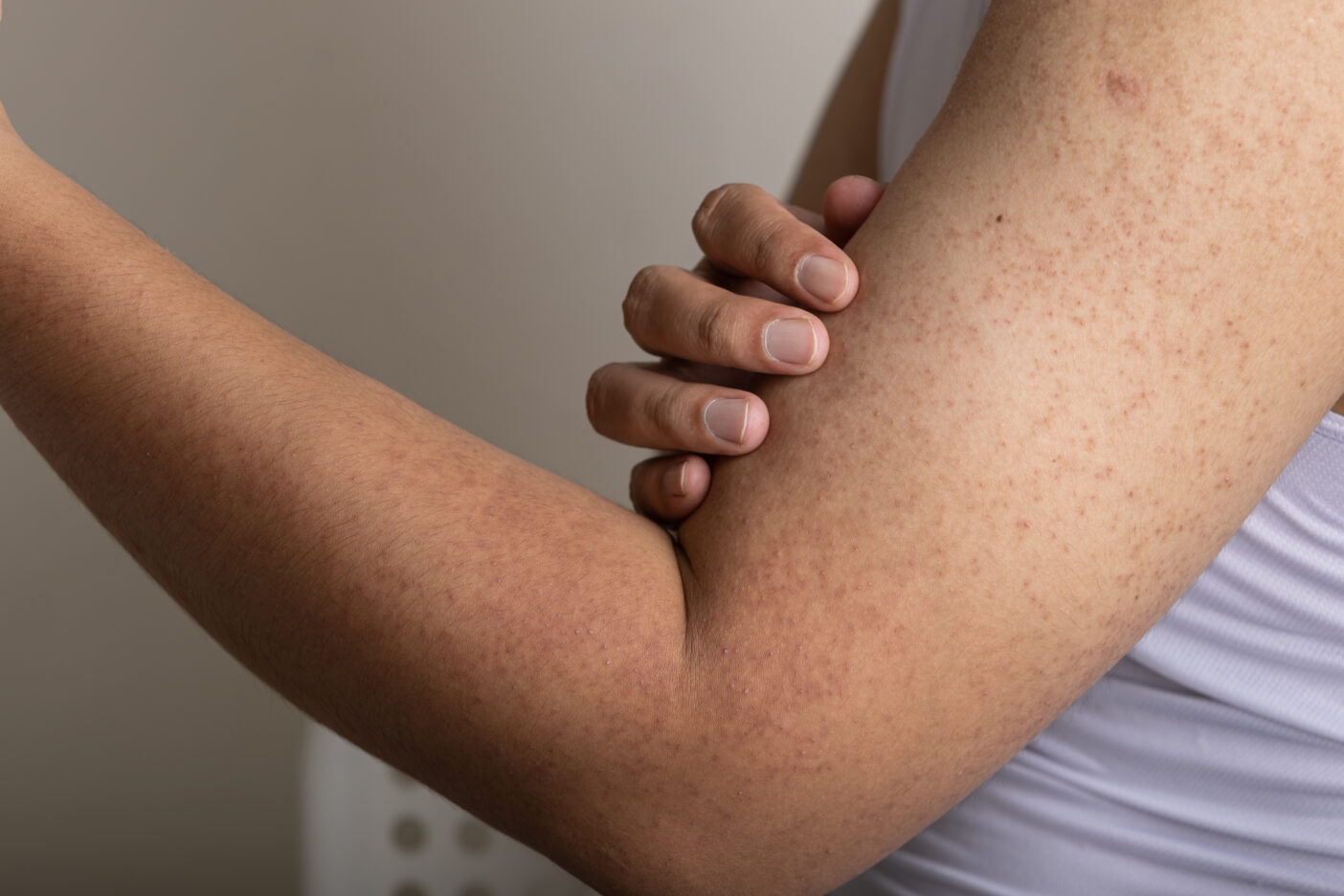What really helps against keratosis pilaris (chicken skin)?

Introduction
Keratosis pilaris or the term ‘chicken skin’ immediately conjures up images of unpleasant, rough, pimple-like patches of skin. It mostly affects the upper arms, thighs or buttocks. The small, firm bumps resemble the skin of a plucked chicken, which is why the colloquial name has become established. The medical terms are keratosis pilaris or mucinosis follicularis.
It affects hair follicles, which become hardened and palpable, which is why it is also known colloquially as grater skin or scurvy goose bumps.
Although it is not a dangerous skin condition, keratosis pilaris is a significant cosmetic concern for many people. In this article, you will learn exactly what causes it, which active ingredients are particularly effective and which products can provide relief.
Causes and appearance
Keratosis pilaris is caused by a keratinisation disorder of the hair follicles. This causes too much keratin to be produced, which clogs the follicles and leads to small papules. These can be reddish, inflamed or simply rough. The skin change occurs particularly frequently in people with dry skin or neurodermatitis. Genetic factors also play a role. Environmental factors such as cold or dry air can further worsen the skin’s appearance.
Effective ingredients for treating keratosis pilaris
Several active ingredients have proven particularly helpful in treating keratosis pilaris:
– Salicylic acid (BHA) has a keratolytic effect, i.e. it dissolves keratin. It penetrates deep into the pores, loosens dead skin cells and has an anti-inflammatory and antibacterial effect. This makes it ideal for treating blocked sebaceous glands.
Glycolic and lactic acids (AHAs) are also keratolytic but water-soluble. They help to gently exfoliate the skin and promote cell renewal. At the same time, they improve the appearance of the skin and make it smoother and more moisturised.
Urea is a natural moisturiser.
In low concentrations, it hydrates the skin, while in higher concentrations it also has a keratolytic effect and effectively dissolves calluses.
Retinoids (e.g. retinol) are vitamin A derivatives that stimulate cell division and regulate excessive keratin production. They promote skin renewal and help to smooth the skin, especially when used regularly.
Hyaluronic acid, ceramides and niacinamide are ideal additions to the treatment. Hyaluronic acid binds moisture, ceramides strengthen the skin barrier and niacinamide has an anti-inflammatory and soothing effect.
Cosmetic product ideas for treating keratosis pilaris
The active ingredients mentioned above can be used to develop targeted care products that effectively help with keratosis pilaris.
Gentle cleansing foam with salicylic and lactic acid optimally prepares the skin for subsequent care and cleanses it thoroughly without irritating it.
Exfoliating creams with glycolic or lactic acid in combination with mechanically effective, very fine particles help to remove calloused skin areas.
A moisturising body lotion with 10% urea and ceramides smoothes the skin and strengthens the skin’s protective barrier – ideal for daily use.
A retinol night cream gently renews the skin structure overnight and reduces excessive keratinisation.
A soothing serum with niacinamide and hyaluronic acid reduces redness and irritation and provides the skin with intensive moisture.
All these products can be used individually or combined in a coordinated skincare routine. Regular use is crucial for success.
When to see a doctor
If the keratosis pilaris is very severe, itchy, inflamed or widespread, it is advisable to consult a dermatologist. In such cases, medical treatment with prescription creams containing corticosteroids or stronger retinoids may be necessary. Laser or light therapies are also used if cosmetic measures are not sufficient.
Conclusion: Keratosis pilaris is treatable.
Even though there is currently no complete cure, the appearance of the skin can be significantly improved with targeted cosmetic care. The combination of keratolytic active ingredients such as salicylic acid, AHAs and urea with moisturising and soothing ingredients such as ceramides, hyaluronic acid and niacinamide achieves the best results. It is important to use the products regularly over several weeks.
Our solution for keratosis pilaris
Keratosis pilaris does not have to be a permanent condition – significant improvements can be achieved with the right care. Cosmacon GmbH develops modern, highly effective cosmetic formulations that specifically address this skin problem. Together with our partner, Tojo Cosmetics GmbH, we are also able to provide high-quality products quickly and reliably as private label products. Whether you have your own brand or a white label, we can help you bring your product line for keratosis pilaris to market.
Literature:
Follicular Mucinosis: A Case Report. Akinsanya AO, Tschen JA.Cureus. 2019 May 24;11(5):e4746.
Primary follicular mucinosis in childhood. Verma P, Kubba A, Jha A.Indian J Dermatol Venereol Leprol. 2019 May-Jun;85(3):333-334